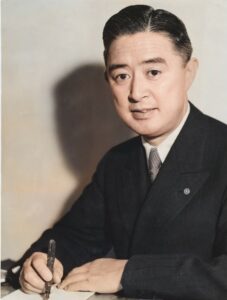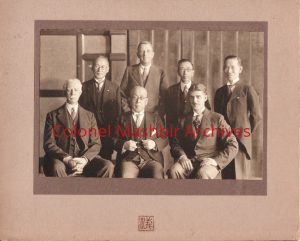
 Prince Iyesato Tokugawa (1863-1940) Takashi Komatsu (1887-1965)
Prince Iyesato Tokugawa (1863-1940) Takashi Komatsu (1887-1965)
Prince Tokugawa was the Heir to the last Shogun, a dynasty that had ruled Japan for 260 years. He served as President of Japan’s Upper House of Congress, was President of the Japanese Medical Association. And held many other leadership positions, shaping international and domestic policies of Japan. Based on his humanitarian accomplishments, US newspapers called him The Prince of Peace. It was only after his passing in 1940, that Japan was pressured by militants to enter WWII against the Allies.
Announcing an important new biographical work released in late 2024:
The Cherry Blossom Weeps for Me: A Quest for the Dawn of Peace, by James Mikel Wilson.
This illustrated biography highlights the untold story of how Prince Tokugawa’s outstanding legacy lived on through his impressive protégé, the Japanese American statesman, Takashi Komatsu. Komatsu relit the torch of friendship and alliance between the US and Japan following WWII. Working with influential American leaders such as General MacArthur, John D. Rockefeller III, and Secretary of State Henry Kissinger, as well as many others.

When the author, James Mikel Wilson, first contacted me several years ago, it was a pleasant surprise. Wilson had read the The Emperor and the Spy, I’d written and was familiar with the illustrated Prince Tokugawa biographies that followed: The Art of Peace and The Art of Diplomacy. Those biographies described Komatsu during the years proceeding WWII. However, Wilson felt Komatsu deserved a biography to reveal how significant Komatsu was during the decades following WWII in re-kindling the strong friendship and alliance between the US and Japan.
“The Cherry Tree Weeps For Me” gives an intimate view of US / Japanese relations during the first 70 years of the 20th Century, beginning the journey through the eyes of twelve old, Komatsu. Who immigrated alone to America to seek his fortune. He would become a vital bridge between the East and West, meeting with Prime Ministers, Generals, US Presidents, and Secretaries of State. While maintaining his integrity and humility. This biography is also a testimonial to Monmouth University in Illinois, which Takashi Komatsu and the James Wilson attended. The book highlights many other alumni from that fine learning institution who took heroic and humanitarian roles linked to international relations – You’ll likely find yourself becoming a friend of Takashi Komatsu, seeing his life devoted to the highest values of humanity: joy, peace, love, and mutual respect.

Circa 1935: Takashi Komatsu takes the place for Prince Tokugawa, who was unable to attend the above diplomatic event. Source: America-Japan Society Press Photo [color enhanced].
Below is a description from the back of the above Photo.
American “Embassy Day” held in Tokyo to Honor New American Consul General and Secretaries. Takashi Komatsu, pinch-hitting for Prince Tokugawa as toastmaster at a recent luncheon of the America-Japan Society held in the Imperial Hotel. This event honored the Consul General and Mrs. George A. Makinson (of San Francisco), first Secretary of the Embassy and Mrs. Stuart E. Grummon (of Newark, N.J.), and Second Secretary and Mrs. W.T. Turner (from Emory, Georgia). Mr. Komatsu [standing], and to his right: Mrs. Makinson (with fur), Mr. Grummon and Mrs. Turner: and to his left: Mrs. Grummon and Consul General Makinson (baldish).
Mr. John L. Curtis, Far Eastern manager of the National City Bank of New York, said he was glad to return to Tokyo, his second home, after a summer in New England. Non-Embassy guests present included Mr. John Moorris, chief of the Far East bureau of the United Press, from Shanghai: Mr. Archibald T. Steele, of the Far East Bureau of the Chicago Daily News; and Captain Maxwell representing the Chicago Tribune, en route from the United States to Berlin via Siberia.
In many ways, The Cherry Tree Weeps for Me, is a sequel to the below books.
Mashbir was a brilliant US intelligence agent. During the 1920 and ‘30s, he allied with Prince Tokugawa, promoting amity between their nations. It was only after Tokugawa’s passing that militants pushed Japan into war.

April, 1937: Imperial Hotel, Tokyo, following a Pan Pacific Club luncheon hosted by Prince Iyesato Tokugawa to honor Colonel Sidney Mashbir’s return visit to Japan. Tokugawa is seated adjacent to his American friend and ally, Mashbir. Accompanying them are several of Tokugawa’s other Japanese and American advisers. There was a rising militant movement in Japan and Mashbir was on a dangerous undercover mission. During Mashbir’s visit, Tokugawa heroically placed his own life in danger by sharing top secret intelligence information with Mashbir to bring back to the U.S. that might have preserved peace between their nations. However, their efforts were undermined. The novel The Emperor and the Spy highlights this untold story.
- Despite their best efforts, WWII could not be stopped….Colonel Mashbir was then recruited by General Douglas MacArthur to command a top-secret intelligence organization ATIS (Allied Translator and Interpreter Section). ATIS grew to almost 5,000 members, and significantly shaped the successful Allied battle strategy in the Pacific, dramatically shortening the war. ATIS was mainly composed of thousands of first generation Japanese Americans (Nisei) who patriotically volunteered to serve under Mashbir’s command, translating and interpreting strategic military documents coming in from the Pacific battlefields. While also interrogating Japanese prisoners of war. And many also heroically went into the battlefield to serve at the front lines. Based on their major contributions, Colonel Mashbir felt the injustice of Presidential Executive Order 9066 that resulted in the illegal imprisonment of loyal Japanese. Approximately 112,000 persons were sent to “relocation centers” that would be their home for the duration of the war. Nearly 70,000 of the evacuees were American citizens. There were no charges of disloyalty against any of these citizens. Nor was there any means they could appeal their loss of property and personal liberty.
- Colonel Mashbir swore that once the war was over, he would devote himself to letting the world know of the major contributions made by patriotic Japanese Americans who had served under his command in ATIS.
- Colonel Mashbir took a major role in ending WWII and orchestrated the Japanese Surrender Signing Ceremony. Thereby avoiding a major destructive battle on mainland Japan.
- Mashbir arranged for General MacArthur and Emperor Hirohito to meet, to plan the rebuilding of Japan and the rekindling of US / Japan friendship. Mashbir served as the translator and facilitator.
 Back cover: The Emperor and the Spy
Back cover: The Emperor and the Spy
Published 2015, 2017, 2019
Available in Print, Kindle, and Audiobook
Here are biographies that highlight the fascinating life of Prince Iyesato Tokugawa.
 Published 2019
Published 2019
KINDLE EDITION
DESCRIPTION OF BOOK COVER PHOTO:
When WWII ended, for various geopolitical reasons there was an urgent agenda in place to leave behind the details of the period leading up to that tragic conflict. And instead, the goal was to expediently reestablish Japan and the U.S. as friends and allies. This resulted in much of the significant peaceful Japanese diplomatic engagement during the prior decades to that war being lost, forgotten, or destroyed – For instance, the above book cover photo comes from what might well be the last remaining crumbling copy of a 1934 Japanese magazine. It presents Prince Tokugawa receiving an Honorary Doctor of Laws Degree from the University of Southern California. The president of the university Dr. Rufus B. von Kleinsmid hands the certificate to Prince Tokugawa. (Left to right in photo: Prince Iyesato Tokugawa; Iyemasa Tokugawa; George I. Cochran; Dr. Rufus B. von Kleinsmid.)
This presentation took place during a special luncheon given March 19, 1934 in Los Angeles, hosted by George I. Cochran, the president of the school’s Board of Trustees. Prince Iyesato Tokugawa was accompanied by his son Iyemasa, the newly appointed Japanese Minister to Canada.
The Los Angeles Times stated that this honorary degree was given to Prince Tokugawa “in recognition of distinguished service in international statesmanship,” and for his “support of many philanthropic and educational movements.”
In accepting the honor, Tokugawa respectfully responded,
“He wished to receive it in the name of the Japanese people as a whole rather than as a personal distinction.”
The Los Angeles Times stated that a banquet dinner was to be hosted by the Japan-America Society of Los Angeles to honor Prince Tokugawa’s visit. The Governor of California and the former Mayor of Los Angeles planned to attend.
Surprisingly, the University of Southern California currently has no record of this event having taken place.
And it’s an intriguing coincidence that during the following year, 1935, President Franklin D. Roosevelt was also awarded an Honorary Doctor of Laws Degree from USC, on October 1, 1935. Prince Tokugawa and President FDR knew each other well. During Tokugawa’s 1934 visit to the U.S. the two men met and discussed ways in which they could maintain amity between their nations. Prince Tokugawa invited FDR to visit Japan with hope that a face to face meeting between US and Japanese leaders including the Japanese Royal Family might strengthen their friendship and understanding.
*The publication of THE ART OF PEACE was brought to the attention of the leadership of USC, revealing significant forgotten history about their school from over 85 years earlier – It is exciting that not long afterwards, USC awarded honorary degrees to former USC Nisei (first generation Japanese-American) students who had not been allowed to continue their education at USC following their release from internment camps. In which they had been unfairly imprisoned during WWII – Many of these former students were deceased, so their honorary degrees were conferred to their families. There is a USC Annenberg Media article about this college degree presentation titled: “President Folt conferred honorary degrees to the families of 33 former Nisei students.” Written by Clara Preve-Durrieu, April 06, 2022. Thus correcting an injustice from the distant past.
The ART OF PEACE was republished in a General Reader Edition titled: THE ART OF DIPLOMACY.
(Note: THE ART OF PEACE has an additional 100 pages of historical notes to assist researchers.)

Print and Kindle Edition
Our times need inspiring role models in the art of peaceful and respectful international diplomacy – It would improve international relations in Asia to recognize Prince Tokugawa’s major humanitarian achievements as President of the Red Cross Society of Japan, promoting the creation of demilitarized safe zones in China. These havens helped protect the lives of hundreds of thousands of Chinese civilians during the years leading up to and during WWII. They also served as refuge for tens of thousands of European Jews fleeing the Holocaust.
During 1921-1922, Prince Tokugawa headed the Japanese Delegation to the Washington Naval Arms Limitation Conference, hoping to maintain peace.
To combat racism, during the 1920s and ’30s, Prince Tokugawa incorporated Lincoln Essay Contests into all Japan’s public schools and universities. Giving awards to students who wrote the best essays honoring the humanitarian principles of Abraham Lincoln.
Prince Tokugawa took a guiding role in 1912 Japanese gifting of Cherry Trees to Washington, D.C. evolving into the National Cherry Blossom Festival, Our capital’s largest annual international goodwill celebration. This achievement has also surprisingly not yet been recognized.
The timing is right to bring deserved international attention to these outstanding statesmen: Prince Tokugawa and Takashi Komatsu.
Reader Praise for:

Leave a Reply